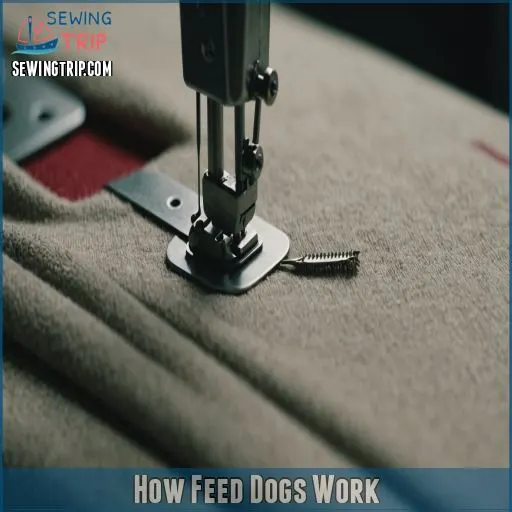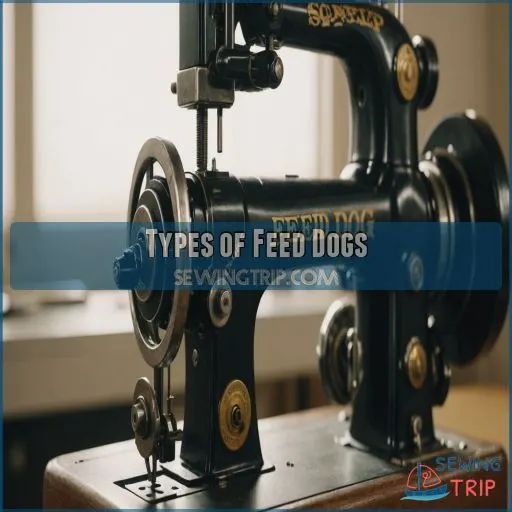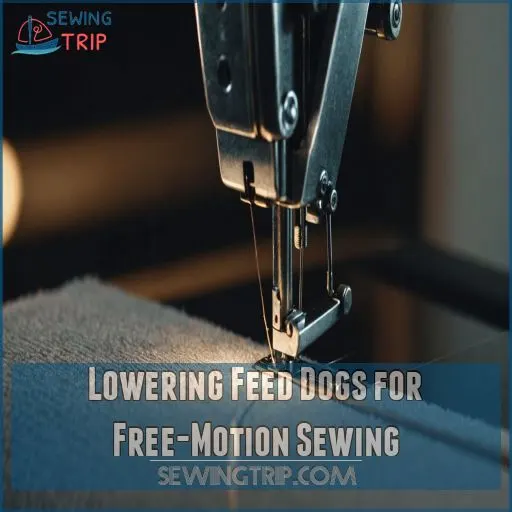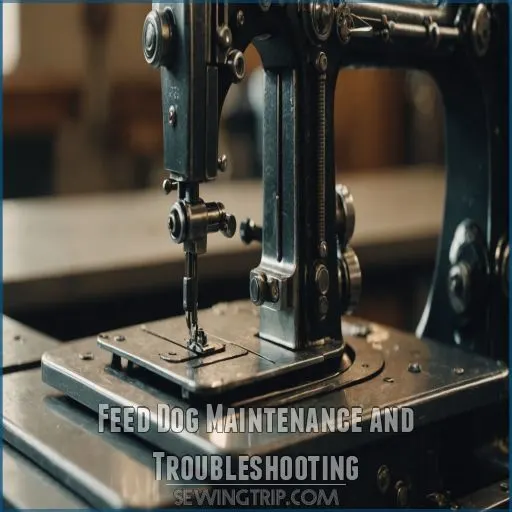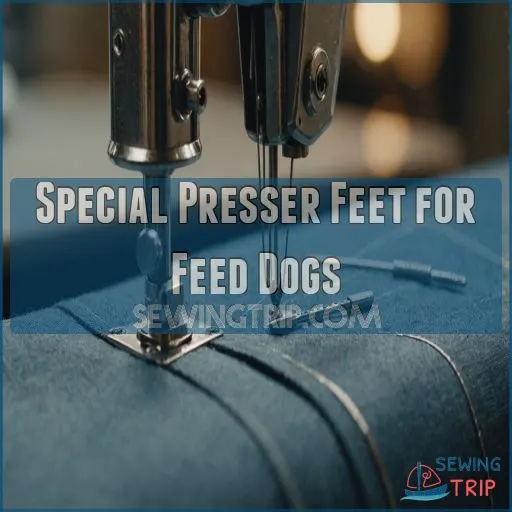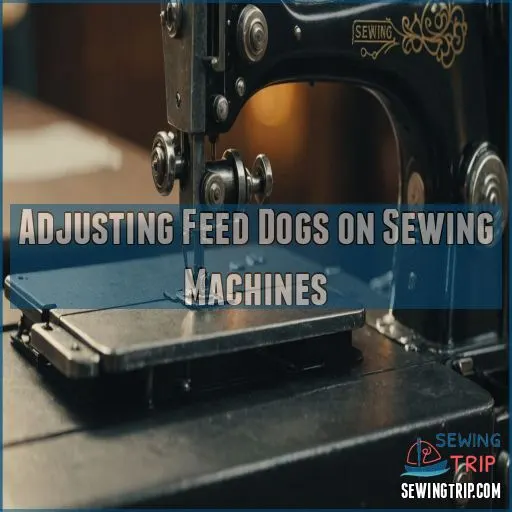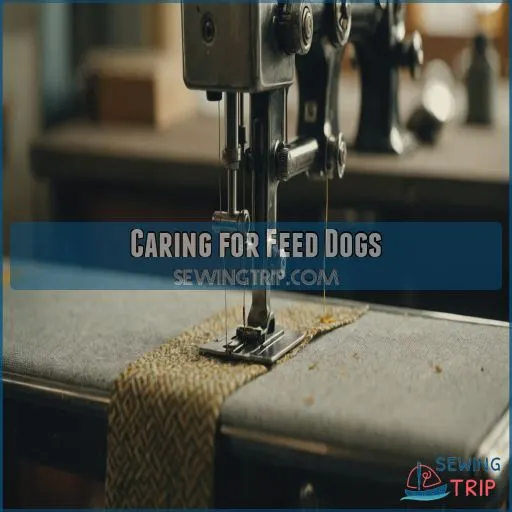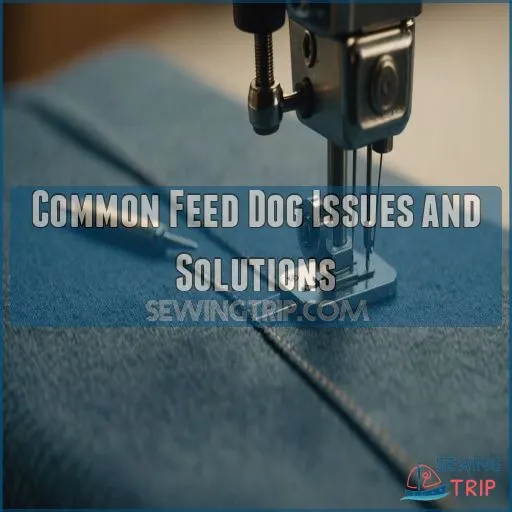This site is supported by our readers. We may earn a commission, at no cost to you, if you purchase through links.
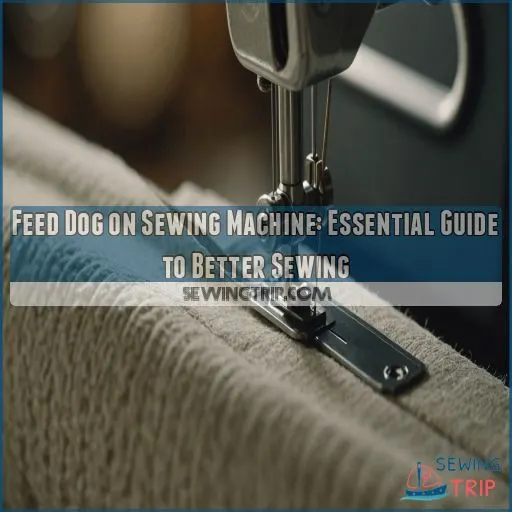
These metal teeth-like ridges beneath the needle plate grab fabric gently yet firmly, guiding it through the machine like a smooth dance partner. Will it waltz or tango? That depends on your fabric and settings!
Mastering feed dogs means ensuring your stitches are perfectly spaced and aligned, whether you’re sewing a delicate silk scarf or robust black denim jeans
. Think of them as your backstage crew, keeping everything running smoothly.
Curious about how to adjust them for different projects? We’ve got some brilliant tips ahead.
Table Of Contents
- Key Takeaways
- What Are Feed Dogs?
- How Feed Dogs Work
- Types of Feed Dogs
- Lowering Feed Dogs for Free-Motion Sewing
- Feed Dog Maintenance and Troubleshooting
- Special Presser Feet for Feed Dogs
- Adjusting Feed Dogs on Sewing Machines
- Caring for Feed Dogs
- Common Feed Dog Issues and Solutions
- Frequently Asked Questions (FAQs)
- Conclusion
Key Takeaways
- Think of feed dogs as your sewing machine’s dance partner. These little metal teeth guide your fabric smoothly through the stitch process, ensuring each stitch is evenly spaced and picture-perfect. Without them, it’s like dancing without rhythm – chaos.
- Adjusting feed dogs is like having a Swiss Army knife for your sewing projects. You can tailor their settings to match your fabric’s needs, whether you’re working with silk or denim. It’s all about finding that sweet spot where your fabric glides effortlessly.
- Feed dogs are low-maintenance buddies, but they do need some TLC. Regular cleaning and a dab of oil keep them running smoothly. It’s like keeping your car’s tires aired up and rotated – this keeps everything moving forward without a hitch.
- Sometimes, adventure calls for dropping the feed dogs completely. This opens up free-motion quilting, where you guide your fabric however you like. It’s like taking off the training wheels and finally riding a bike – it’s freeing and a bit exciting.
What Are Feed Dogs?
Have you ever wondered about those mysterious metal teeth-like ridges on your sewing machine?
Those are called feed dogs, and they’re an essential part of your machine that helps guide your fabric through the stitching process.
Discover how these unsung heroes make your sewing experience smoother and more efficient.
Metal Teeth-Like Ridges on Sewing Machines
Imagine tiny metallic teeth working behind the scenes—those are your sewing machine’s feed dogs.
These little wonders grab your fabric and move it through the machine with remarkable precision.
Nestled beneath the needle plate and just under the presser foot, they make sure each stitch is smooth and consistent.
Without them, sewing would be like driving a car without tires, highlighting their crucial role in the sewing machine.
Function of Feed Dogs in Sewing Machines
Feed dogs on sewing machines work their magic by gently gripping and guiding fabric through the sewing machine basics, almost like a tiny dance partner supporting your every move
.
They’re the little metal teeth ensuring your stitches remain consistently spaced and straight .
With these helpful helpers in action, you’ll achieve sewing techniques that lead to neat, high-quality results.
Importance of Feed Dogs in Sewing
In sewing, the feed dog is like your trusty assistant that helps maintain fabric control and makes your stitches even and consistent.
By gently advancing the fabric under the needle, these teeth guarantee precision without the hassle.
Whether you’re quilting or tackling thick materials, understanding feed dog types and care can enhance your sewing prowess and machine longevity.
How Feed Dogs Work
Understanding how feed dogs work can make all the difference in your sewing projects.
These clever little metal teeth synchronize seamlessly with your sewing machine’s stitch process, ensuring your fabric glides smoothly without a hitch during timing adjustments like fixing timing issues
.
This synchronization is key unless you fancy unraveling every thread like a cat dangling from a ball of yarn, which is the opposite of the desired effect of using a sewing machine.
Drive Mechanism and Serrated Metal Teeth
Through clever engineering, the sewing machine’s feed dogs — those serrated metal teeth beneath your fabric — move up and down in a synchronized dance.
This allows them to grip, push, and pull your fabric along smoothly, ensuring it advances seamlessly under the needle.
It’s akin to your own personal assistant, keeping everything running without a hitch
Synchronization With Stitch Formation Process
Picture feed dogs as ready helpers synchronizing perfectly with stitch formation.
Like a well-timed dance, the needle’s alignment with the stitch timing makes sure each step matches the feed dog speed. This teamwork retains fabric tension, promising stitch quality.
You might even say they’ve a rhythm, keeping beat even through multiple layers of fabric, enabling creativity with ease.
Adjusting Feed Dog Movement for Different Fabrics
Adjusting your sewing machine’s feed dogs for freehand sewing techniques is key for tackling different fabrics
.
Start by swapping in the right feed dogs – lightweight for delicates, heavy-duty for denim.
Then, fine-tune the height so the valleys align with the throat plate .
This evens out the stitch and prevents bunching or slippage, no matter the project.
Types of Feed Dogs
When it comes to sewing machines, feed dogs are like your trusty sidekicks, each type ready for a different challenge.
Whether you’re tackling thick fabrics, free-motion designs, or general sewing tasks, knowing your feed dog options can make your stitching smoother and more enjoyable.
Standard Feed Dogs for General Sewing
Let’s talk about standard feed dogs, your sewing machine’s unsung heroes. They guide fabric smoothly, making sure every stitch is precise.
- Clean regularly: Remove lint and debris for smooth fabric feeding.
- Lubricate gently: A drop of sewing machine oil works wonders.
- Monitor adjustments: Make sure proper alignment to prevent issues.
Drop Feed Dogs for Free-Motion Sewing
Switch from standard to drop feed dogs for free motion quilting, and you open up creativity by controlling fabric movement yourself
.
It’s like yoga for your needle—you guide, it follows.
While drop dogs are classic for freehand quilting, don’t stress; some quilters keep them up and adjust stitch length instead.
Always test your setup to avoid puckering in rag or denim quilts (Source).
Walking Foot Feed Dogs for Thick Fabrics
When tackling thick fabric sewing, consider a walking foot. It helps both fabric layers move together, avoiding pesky shifting.
Here’s how:
- Quilting with a walking foot keeps lines straight and layers in sync.
- Choosing the right walking foot depends on your machine type.
- Enjoy smoother sessions than with standard feed dogs!
Differential Feed Dogs for Sergers
Differential feed dogs on a serger are your secret weapon for taming tricky fabrics.
They let you adjust how fabric feeds, preventing knits from waving and lightweight materials from puckering.
Want to gather fabric or create a smooth finish? A simple twist of the dial helps you master these sewing techniques effortlessly, putting you in control to achieve a perfect gather fabric technique.
Lowering Feed Dogs for Free-Motion Sewing
Lowering the feed dogs is like releasing the reins, giving you total control for creative free-motion sewing.
Whether you’re taking a quilting adventure or sketching fabric art, mastering this technique lets you dance the fabric to your tune.
When to Lower Feed Dogs for Free-Motion Techniques
Venturing into free-motion quilting? The choice to lower feed dogs can be as personal as choosing your favorite quilting techniques.
Lowering them disengages their pull, giving you full control, especially with a darning foot.
It’s like riding a bike without training wheels—liberating yet challenging. Try it with free-motion embroidery to see if it enhances your creative flow.
Methods for Lowering Feed Dogs on Sewing Machines
Lowering feed dogs can be a breeze, whether you’re using manual methods or automatic lowering.
On many machines, a simple switch or lever will do the trick, letting you start free-motion quilting without a hitch.
If your machine doesn’t have this feature, adjusting stitch length to zero is a clever workaround, helping you ace that quilting challenge effortlessly.
Using Special Plates or Covers to Lower Feed Dogs
If you’re diving into free-motion quilting, covering your feed dogs can work wonders.
Here’s how:
- Use darning foot for smoother fabric movement.
- Attach quilting plates to stop unwanted tugging.
- Opt for plastic covers to glide effortlessly over fabric.
- Try feed dog covers for an even quilting experience.
These tricks can transform your quilting!
Feed Dog Maintenance and Troubleshooting
Keeping your sewing machine’s feed dogs in top shape is a bit like keeping your cat content.
Cleaning, a little lubrication, and regular attention do wonders.
Don’t ignore them, or you might end up with more puckers than a toddler’s pout during snack time, resulting in a big pout.
Regular Cleaning of Feed Dogs
Keeping your sewing machine’s feed dogs lint-free is important for smooth fabric movement.
Use cleaning tools like a soft brush or pipe cleaner to gently remove stubborn lint.
Make feed dog maintenance a routine by setting a regular cleaning schedule.
Remember, prevention is key—keep your sewing area tidy to reduce lint buildup and make sure your machine runs like a dream.
Lint Removal and Lubrication
You’re tackling lint? Grab your trusty lint brush and start cleaning those feed dogs! Use a pin for stubborn bits. To keep things shipshape, create a maintenance schedule.
- Choose the right oil: a drop on a moving part keeps it smooth.
- Regular cleaning protects your investment.
- Tools matter: keep them handy and make sure your machine’s in top sewing form .
Replacing Damaged or Worn-Out Feed Dogs
Noticing those worn feed dogs?
Don’t fret – it’s an easy fix!
First, check your machine manual for the right replacement parts. Gently remove the old ones, taking care not to strip the screws.
Then, simply pop in the new feed dogs and adjust them to perfection. Your machine will sew like new in no time, after a quick easy fix!
Special Presser Feet for Feed Dogs
When you’re sewing, the right presser foot can make all the difference.
Turning a simple task into an effortless glide, it can greatly impact your sewing experience.
From darning feet for free-motion quilting to those with built-in feed dogs, these specialized tools help you tackle tricky fabrics.
They make sure your stitches stay even and true, like a trusty backup dancer for fabric, providing consistent results and making the sewing process more enjoyable.
Darning Feet for Free-Motion Quilting
Ah, the darning foot—the unsung hero of free-motion quilting.
You’ve got options: open toe, closed toe, even a modified version with a rubber band hack to keep stitches smooth.
Whether you’re stitching spirals or doodles, this foot helps control movement and manage tension.
Get started and master quilting techniques with humor and grace!
Presser Feet With Built-in Feed Dogs
Imagine your sewing machine’s presser feet chatting over coffee, one casually mentioning it’s got built-in feed dogs and talking about their favorite sewing machine presser feet
.
These unique presser feet enhance your crafting adventures by helping you:
- Make sure smooth fabric movement, even with thick layers.
- Improve stitch quality for tricky projects.
- Reduce fabric slipping and puckering.
- Simplify maintenance with easy adjustments.
They’re like having an extra pair of crafty hands!
Customized Presser Feet for Specific Sewing Tasks
You’ve got presser feet designed for every sewing occasion!
Picture using a binding foot for neat edges or quilting feet perfect for those precise fabric layers.
Free-motion embroidery and decorative stitches come alive with these specialized tools.
From the appliqué foot to a binding foot, each has its role, making your sewing adventures smoother and more controlled.
Preventing Puckering and Bunching of Fabric
Tired of fabric puckering?
Try a walking foot. It mimics feed dogs to prevent stretching, ensuring smooth fabric feeding.
Adjust fabric tension, needle size, and presser foot pressure for your specific fabric type. Remember, a zigzag stitch can help too.
With these tweaks, your fabric will glide like butter, leaving puckering in the dust (Source).
Ensuring Consistent Stitch Length and Spacing
To master consistent stitch length and spacing, balance fabric tension and feed dog alignment.
Choose the right needle size and adjust presser foot pressure for perfect results. A walking foot helps even fabric feed, preventing top layers from lagging behind the bottom ones.
It’s like having a dance partner who never misses a step! .
Saving Time and Effort With Feed Dogs
Ditch the tedious manual fabric feeding and let your sewing machine’s feed dogs do the heavy lifting.
These clever mechanisms save you time and effort, effortlessly guiding your fabric through each stitch.
Harness their power by pairing them with specialized presser feet for flawless results, whether you’re quilting, sewing thick materials, or tackling tricky patterns.
Adjusting Feed Dogs on Sewing Machines
Adjusting feed dogs on your sewing machine can seem like a tiny mystery, but it’s easier than finding that one lost sock in the laundry!
Just use the control levers or knobs to raise or lower them for different fabrics.
And don’t forget to consult your machine manual—it’s your sewing machine’s secret decoder ring.
Using Feed Dog Control Levers or Knobs
Adjusting the feed dog lever on your sewing machine is like discovering a secret button to another world of stitching possibilities.
Whether you’re dealing with different machine types or adjusting speed, find the lever and make sure it’s in the right position.
Avoid common mistakes like forcing it, and remember: sometimes, the machine just needs a little coaxing to get moving smoothly.
It also requires knowing when to use the right amount of force and when to be gentle, especially when dealing with a machine that needs a little help to get moving.
Lowering or Raising Feed Dogs for Specific Fabrics
When you’re sewing with various fabric types, try tweaking the feed dog settings to boost your stitch quality.
Use the control levers to lower or raise the feed dogs, letting challenging materials flow like a dream.
Remember, a balance in the feed dog height makes for smooth fabric feeding—just avoid letting your fabric do a dance it’s not ready for!
Referencing Machine Manuals for Adjustments
Got feed dog quirks? Grab your sewing machine manual!
These diagrams are like a GPS for feed dog types and specific adjustments—perfect across sewing machine brands.
When your fabric goes rogue, a troubleshooting guide and the manual’s wisdom have your back.
It’s the key to mastering that perfect stitch with precision and flair, without pulling your hair out, to achieve a perfect stitch.
Caring for Feed Dogs
You mightn’t think about feed dogs much, but they need some TLC to keep your sewing smooth and fabric hassle-free.
Regularly cleaning out lint and applying a bit of lubricant will make you and your sewing machine the best of friends.
They are also key to ensuring a smooth sewing experience.
Cleaning and Lubricating Feed Dogs
To keep your sewing humming smoothly, feed dog maintenance is key.
Use:
- A soft brush for lint removal
- Sewing machine oil for lubrication
- Flannel scraps or tissues
- A small screwdriver
- Your trusty manual for guidance
Lightly oil the feed dogs, but avoid a greasy mess. Weekly checks keep your fabric flowing effortlessly under those metal teeth.
Removing Lint and Thread Bits
Grab that trusty lint brush and give those feed dogs a good scrub-down.
Gently poke at any stubborn thread bits or compressed lint using a soft-bristled brush or a toothpick – just be careful not to damage the delicate mechanisms.
Regular cleaning keeps your machine humming along smoothly and makes sure those feed dogs do their job properly.
Following Manufacturer Instructions for Maintenance
After tidying up your feed dogs, keep your sewing machine purring by following manufacturer instructions to the letter. It’s your machine’s lifeline.
A regular cleaning schedule, proper lubrication, and even timely needle replacements play a starring role in keeping things smooth.
Don’t skip the warranty instructions—they’re your safety net! Happy sewing—may your stitches be straight and your fabric feed like a dream!
Common Feed Dog Issues and Solutions
Even seasoned crafters face common tug-of-war scenarios with feed dogs on their sewing machines.
Leading to uneven stitch lengths or stubbornly stalled fabrics.
We’ll untangle these pesky challenges with simple solutions, helping you sew smoothly without those frustrating fabric imprints that seem to declare war on your perfect project.
Uneven Stitch Length and Fabric Stalling
Ever feel like your sewing project hit a snag? Uneven stitch length and fabric stalling could be the culprits.
Let’s look at some solutions:
- Check for tension issues or needle problems
- Adjust for fabric thickness
- Balance presser foot pressure
- Clean out lint in the bobbin area
- Consider a walking foot for smoother feeds
These tips can untangle your troubles!
Feed Dog Imprints on Fabric and Solutions
When you spot unwanted feed dog imprints on your fabric, adjust the presser foot pressure and try a different needle type to minimize them.
Thicker fabrics might require changes in feed dog height to reduce these marks.
Experiment with these troubleshooting steps and see significant improvements, ensuring your stitches are the envy of sewing circles everywhere, with significant improvements .
Troubleshooting and Resolving Feed Dog Problems
Is your sewing fabric bunching or stitches turning uneven?
A little maintenance magic can keep feed dogs snapping at fabric properly.
First, give them a clean—they can’t bite if clogged with lint. Next, check feed dog height; adjust it to engage fabric evenly.
Sometimes, they just need a lift to work correctly, and even a troubled feed dog deserves some TLC.
Frequently Asked Questions (FAQs)
What is a sewing machine feed dog?
Picture tiny metal teeth on your machine, ready to bite into fabric. A sewing machine feed dog grips the fabric, smoothly guiding it under the needle for consistent stitches.
It’s your secret ally for flawless sewing.
What kind of dog do you feed a sewing machine?
You can’t feed a sewing machine a real dog, but the "feed dogs" on a sewing machine are metal bars that grip fabric, moving it through the machine while you sew.
It’s a pun-worthy term in sewing humor.
Do you need a feed dog for a sewing machine?
Think of feed dogs as your sewing machine’s trusty steed, guiding fabric smoothly like reins.
While essential for regular sewing, they aren’t needed for free motion quilting, where fabric control is entirely in your hands.
How to cover a feed dog in a sewing machine?
To cover a feed dog on a sewing machine, use a darning plate or tape to protect the fabric.
This lets you smoothly move your fabric for techniques like free motion quilting without snagging.
How do you raise the feed dog on a sewing machine?
Master the magic of manipulating your machine’s mechanisms by ensuring the needle’s poised at its peak.
Then slide the feed dog lever left.
Rotate the handwheel entirely—this charming twist should raise those fabric-moving marvels.
Why are they called feed dogs?
They’re called feed dogs because "dogs" are mechanical devices that grip and move objects, like a dog’s teeth.
The sewing machine’s feed mechanism, with toothed ridges, moves fabric similarly, resembling a dog gently pulling on something (Source).
What makes feed dogs move on a sewing machine?
Buckle up, folks! The feed dogs on your sewing machine are like tiny, ravenous beasts that devour the fabric, propelling it through the machine with lightning speed.
Their synchronized dance with the needle makes your stitches as straight as an arrow.
What is the difference between presser foot and feed dog?
Your sewing machine’s presser foot holds fabric down while the feed dogs below pull it through for stitching.
Think of feed dogs as a conveyor belt and the presser foot as the guiding hand keeping things steady.
How do I move the quilt smoothly during free-motion quilting?
Use quilting gloves for better grip, and make sure your machine surface is smooth to prevent sticking.
Adjust the presser foot height and use a quilting table for more quilt support.
These help move it smoothly.
What type of batting is best for machine quilting?
For machine quilting, cotton or cotton/poly blend battings with scrim are your trusty sidekicks.
They offer stability, letting you space your quilting lines up to 12 inches apart without a hitch.
How do I mark quilting designs on my fabric?
To mark quilting designs on fabric, choose tools for precise lines.
Always test on scrap fabric first to make sure marks wash out completely.
Avoid using Frixion pens due to ghosting issues.
What is the best sewing machine for free-motion quilting?
Imagine effortlessly quilting like a pro—consider the Pfaff 1222E or Elna eXcellence These machines, with their sturdy builds and excellent threads compatibility, transform free-motion quilting from intimidating to delightful.
How do I block my quilt to make it hang straight?
Start by pinning the quilt to a clean, flat surface, ensuring edges are straight using a ruler or string.
Steam with a steam iron, gently pressing out bumps.
Let it dry completely to achieve a perfectly straight hang.
Conclusion
Mastering your sewing machine’s feed dogs may seem tricky, but with a little know-how, you’ll be sewing like a pro in no time.
From adjusting them for different fabrics to keeping them well-maintained, these unsung heroes are the key to achieving flawless stitches every time.
So don’t be intimidated – jump in and let the sewing success guide you to sewing success!


